
Rush was a Canadian rock band that primarily comprised Geddy Lee, Alex Lifeson (guitar) and Neil Peart. The band formed in Toronto in 1968 with Lifeson, drummer John Rutsey, and bass guitarist/vocalist Jeff Jones, whom Lee immediately replaced. After Lee joined, the band went through several line-up changes before arriving at its classic power trio lineup with the addition of Peart in July 1974, who replaced Rutsey four months after the release of their self-titled debut album; this lineup remained intact for the remainder of the band's career.
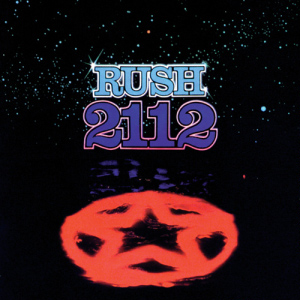
2112 is the fourth studio album by Canadian rock band Rush, released in March 1976 by Anthem Records. It reached No. 5 in Canada and became the band's commercial breakthrough in the US, peaking at No. 61.
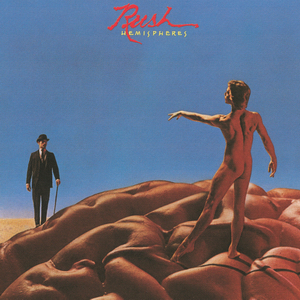
Hemispheres is the sixth studio album by Canadian rock band Rush, released in October 1978 by Anthem Records. After touring to support the band's previous release, A Farewell to Kings, during which the group gained popularity in the UK, Rush started work on their next album. As with the band's previous studio album, Hemispheres was recorded at Rockfield Studios in Monmouthshire and Trident Studios in London with longtime engineer and arranger, Terry Brown. Rush continued its progressive rock sound with the side-long "Cygnus X-1 Book II: Hemispheres" and the nine-minute instrumental "La Villa Strangiato", which was the band's first instrumental piece.

A Farewell to Kings is the fifth studio album by Canadian rock band Rush, released in September 1977 by Anthem Records. After touring their previous album 2112 (1976), which saw the group reach a new critical and commercial peak, they started work on a follow-up. They decided to record at Rockfield Studios in Wales, the first time Rush recorded an album outside of Toronto. The band expanded their sound with each member playing new instruments that they had not previously used, and recorded a mix of concise and long songs.

Fly by Night is the second studio album by the Canadian rock band Rush, released on February 14, 1975, by Mercury Records. It was the first Rush album to showcase elements of progressive rock for which the band has become known. It was also the first to feature lyricist and drummer Neil Peart, who replaced original drummer John Rutsey the previous summer just prior to the band's first North American tour. Peart took over as Rush's primary lyricist, and the abundance of fantastical and philosophical themes in his compositions contrasted greatly with the simpler hard rock of the band's debut album.
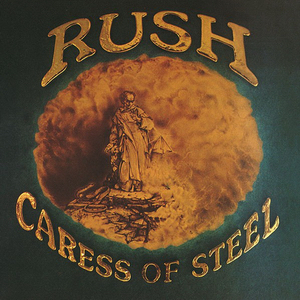
Caress of Steel is the third studio album by Canadian rock band Rush, released on September 24, 1975, by Mercury Records. It was recorded immediately after the band concluded touring in support of their previous album, Fly By Night, and marked a development in the group's sound, moving from the blues-based hard rock style of their debut towards progressive rock. Songs such as "The Necromancer" furthered Rush's advancement into narrative-driven, fantasy-based compositions, while "The Fountain of Lamneth" was their first prog-rock "epic" to span an entire side of vinyl. Other tracks like "Bastille Day" and "Lakeside Park" became staples of the band's live setlists.
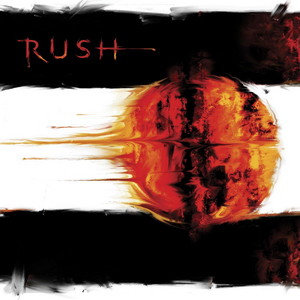
Vapor Trails is the seventeenth studio album by Canadian rock band Rush. It was released on May 14, 2002, on Anthem Records, and was their first studio release since Test for Echo (1996), the longest gap between two Rush albums. After the Test For Echo tour finished in July 1997, drummer and lyricist Neil Peart suffered the loss of his daughter and then his wife in separate tragedies. As a result, the group entered an extended hiatus during which it was not certain they would continue. They eventually reunited in January 2001 to rehearse material for a new album, recording for which lasted until December. For the first and only time since Caress of Steel (1975), the group did not use any keyboards or synthesizers in their music, incorporating many layers of guitar, bass and drums instead.

Roll the Bones is the fourteenth studio album by Canadian rock band Rush, released September 3, 1991, on Anthem Records. The band began working on the album after a brief creative hiatus following the tour promoting their previous release, Presto (1989).
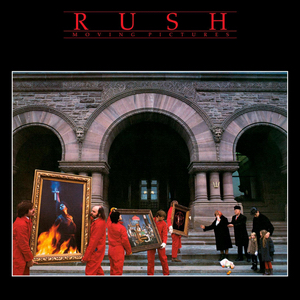
Moving Pictures is the eighth studio album by Canadian rock band Rush, released on February 12, 1981 by Anthem Records. After touring to support their previous album, Permanent Waves (1980), the band started to write and record new material in August 1980 with longtime co-producer Terry Brown. They continued to write songs with a more radio-friendly sound, featuring tighter and shorter song structures compared to their earlier albums.

Permanent Waves is the seventh studio album by Canadian rock band Rush, released on January 18, 1980, through Anthem Records. After touring to support their previous album, Hemispheres (1978), the band began working on new material for a follow-up in July 1979. This material showed a shift in the group's sound towards more concise arrangements and radio-friendly songs, though their progressive rock blueprint is still evident on "Jacob's Ladder" and the nine-minute closer "Natural Science." Bassist/vocalist Geddy Lee also employed a more restrained vocal delivery compared to previous albums. Permanent Waves was recorded at Le Studio in Morin-Heights, Quebec with production handled by the group and Terry Brown.
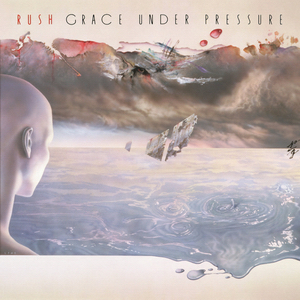
Grace Under Pressure is the tenth studio album by Canadian rock band Rush, released April 12, 1984, on Anthem Records. After touring for the band's previous album, Signals (1982), came to an end in mid-1983, Rush started work on a follow-up in August. The band had decided to not work with longtime producer Terry Brown, who had collaborated with Rush since 1974. The new material accentuated the group's change in direction towards a synthesizer-oriented sound like its previous album. After some difficulty finding a suitable producer who could commit, the album was recorded with Peter Henderson.

Power Windows is the eleventh studio album by Canadian rock band Rush, released on October 11, 1985 in Canada by Anthem Records and on October 21, 1985 in the United States. After touring in support of their previous album, Grace Under Pressure (1984), the band took a break and reconvened in early 1985 to begin work on a follow-up. The material continued to display the band's exploration of synthesizer-oriented music, this time with the addition of sampling, electronic drums, a string section, and choir, with power being a running lyrical theme. Power Windows was recorded in Montserrat and England with Peter Collins as co-producer and Andy Richards on additional keyboards.
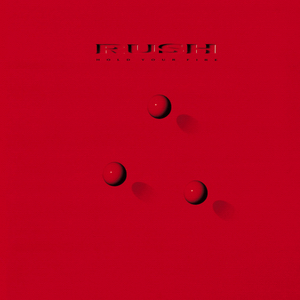
Hold Your Fire is the twelfth studio album by Canadian rock band Rush, released on September 8, 1987. It was recorded at The Manor Studio in Oxfordshire, Ridge Farm Studio in Surrey, Air Studios in Montserrat and McClear Place in Toronto. Hold Your Fire was the last Rush studio album released outside Canada by PolyGram/Mercury. 'Til Tuesday bassist and vocalist Aimee Mann contributed vocals to "Time Stand Still" and appeared in the Zbigniew Rybczyński-directed video.

Presto is the 13th studio album by Canadian rock band Rush. It was released on November 17, 1989 by Anthem Records and was the band's first album released internationally by Atlantic Records, following the group's departure from Mercury. After the Hold Your Fire (1987) tour ended in 1988, the group members reconvened in December to decide their next step and agreed to take six months off before starting on a new album. Presto marked another change in Rush's sound, with guitar taking a more dominant role in the writing, a reduction in synthesizers and a return towards more guitar-driven arrangements.

Counterparts is the fifteenth studio album by Canadian rock band Rush, released October 19, 1993, on Anthem Records. After the band finished touring its previous album Roll the Bones (1991) in mid-1992, the members took a break before starting work on a follow-up.

Test for Echo is the sixteenth studio album by the Canadian rock band Rush, released on September 10, 1996 on Anthem Records. It was the final Rush album to be co-produced by Peter Collins. The band supported the album with a world tour in 1996 and 1997, after which they went on a five-year hiatus following the deaths of drummer Neil Peart's daughter and wife, and would not record again until 2001.

"Tom Sawyer" is a song by Canadian rock band Rush, originally released on their 1981 album Moving Pictures as its opener. The band's lead singer, bassist, and keyboardist, Geddy Lee, has referred to the track as the band's "defining piece ... from the early '80s". It is one of Rush's best-known songs and a staple of both classic rock radio and Rush's live performances, having been played on every concert tour since its release.
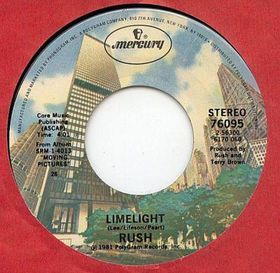
"Limelight" is a song by Canadian progressive rock band Rush. It first appeared on the 1981 album Moving Pictures. The song's lyrics were written by Neil Peart with music written by Geddy Lee and Alex Lifeson. "Limelight" expresses Peart's discomfort with Rush's success and the resulting attention from the public. The song paraphrases the opening lines of the "All the world's a stage" speech from William Shakespeare's play As You Like It. The band had previously used the phrase for its 1976 live album. The lyrics also refer to "the camera eye", the title of the song that follows on the Moving Pictures album.

Snakes & Arrows is the eighteenth studio album by Canadian rock band Rush, released on May 1, 2007, by Anthem Records. After their R30: 30th Anniversary Tour ended in October 2004 the band took a one-year break, during which they agreed to start work on a follow-up in January 2006. The album was recorded in five weeks with co-producer Nick Raskulinecz, a fan of the group who was praised by each member for his approach and technique. It contains three instrumental tracks, the most on any Rush album.
"Witch Hunt" is a song by Canadian rock band Rush. It was released on their 1981 album Moving Pictures, and unlike many other Rush songs it was a true studio production, with a variety of percussion instruments and overdubs, and a separate keyboard player. It is the first of four songs in what has been called the band's "Fear" series, the other three being "The Weapon", "The Enemy Within", and "Freeze", although this song is the third part of the series in order, and went on reverse chronological order by the album.




















